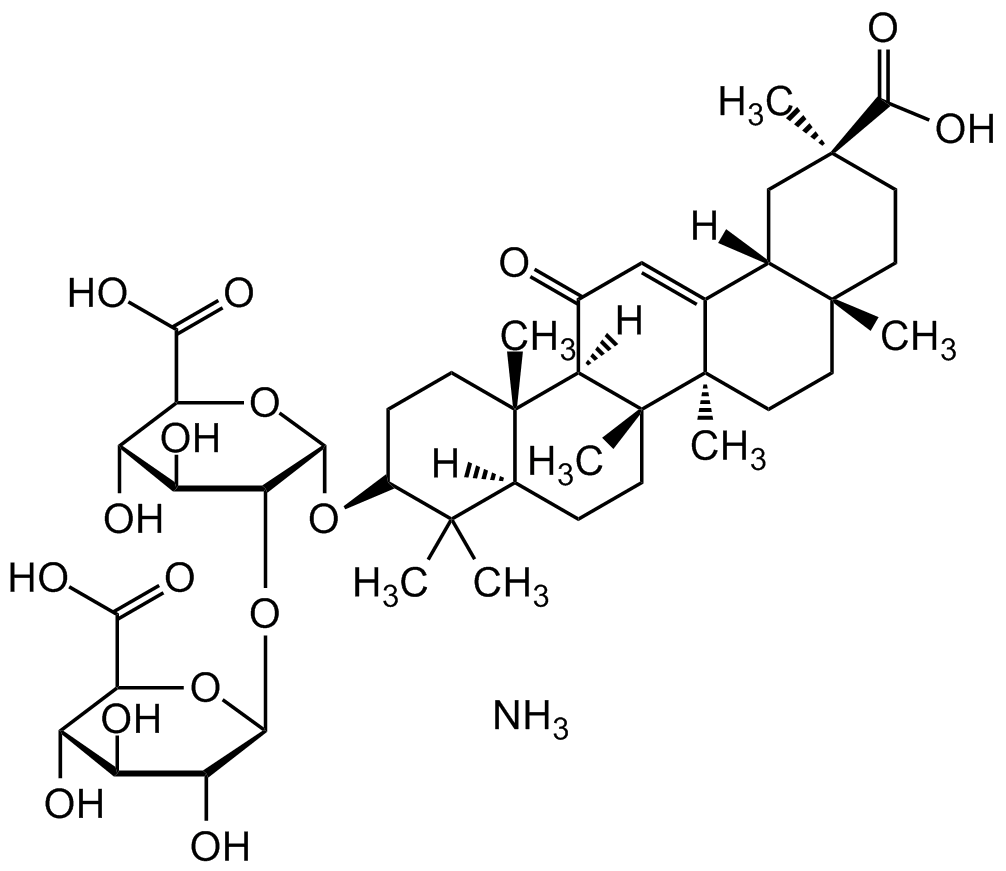Glycyrrhizic acid ammonium salt
| Code | Size | Price |
|---|
| CDX-G0215-G025 | 25 g | £78.00 |
Quantity:
| CDX-G0215-G100 | 100 g | £255.00 |
Quantity:
Prices exclude any Taxes / VAT
Overview
Host Type: Plant
Regulatory Status: RUO
Shipping:
AMBIENT
Storage:
Short Term: +20°C, Long Term: +4°C
Images
Documents
Further Information
Alternate Names/Synonyms:
Glycyrrhizin; 3-O-(2-O-beta-D-Glucopyranuronosyl-alpha-D-glucopyranuronosyl)-18beta-glycyrrhetinic acid ammonium salt; Monoammonium glycyrrhizinate; NSC 2800; NSC 35348
Appearance:
White powder.
CAS:
53956-04-0
EClass:
32160000
Form (Short):
liquid
Handling Advice:
Protect from light and moisture.
InChi:
InChI=1S/C42H62O16.H3N/c1-37(2)21-8-11-42(7)31(20(43)16-18-19-17-39(4,36(53)54)13-12-38(19,3)14-15-41(18,42)6)40(21,5)10-9-22(37)55-35-30(26(47)25(46)29(57-35)33(51)52)58-34-27(48)23(44)24(45)28(56-34)32(49)50;/h16,19,21-31,34-35,44-48H,8-15,17H2,1-7H3,(H,49,50)(H,51,52)(H,53,54);1H3/t19-,21-,22+,23-,24-,25-,26-,27+,28-,29-,30+,31+,34-,35-,38+,39-,40-,41+,42+;/m0./s1
InChiKey:
ILRKKHJEINIICQ-IERXZFCASA-N
Long Description:
Chemical. CAS: 53956-04-0. Formula: C42H62O16 . NH3. MW: 839.96. Glycyrrhizic acid is a natural triterpenoid saponin. It is an agonist of the human sweet taste receptor and is used as a flavorant. Glycyrrhizic acid has diverse biological activities, including antioxidant, anti-inflammatory, antidiabetic, anticancer, antimicrobial, hepatoprotective, neuroprotective and antiviral actions. Glycyrrhizic acid has been shown to be a 11-beta-hydroxysteroid dehydrogenase inhibitor, a functional inhibitor of HMGB1 and a highly selective and competitive inhibitor of kynurenine aminotransferase 2 (KAT2). It can enhance GLP-1 secretion through TGR5 activation and has an anti-inflammatory effect by attenuating the generation of excessive NO, PGE(2), and ROS and by suppressing the expression of pro-inflammatory genes through the inhibition of NF-kappa and PI3K activity. It has anti-angiogenic and apoptosis inducing properties. In addition, due to its amphiphilic nature glycyrrhizic acid is able to form self-associates in aqueous and non-aqueous media, as well as water soluble complexes with a wide range of lipophilic drugs. It has been identified as promising carrier material for anticancer therapy, due to its anti-cancer-related pharmacological activities, such as broad-spectrum anti-cancer ability, resistance to the tissue toxicity caused by chemotherapy and radiation, drug absorption enhancing effects and anti-multidrug resistance (MDR) mechanisms.
MDL:
MFCD00167400
Molecular Formula:
C42H62O16 . NH3
Molecular Weight:
839.96
Package Type:
Vial
Product Description:
Glycyrrhizic acid is a natural triterpenoid saponin. It is an agonist of the human sweet taste receptor and is used as a flavorant. Glycyrrhizic acid has diverse biological activities, including antioxidant, anti-inflammatory, antidiabetic, anticancer, antimicrobial, hepatoprotective, neuroprotective and antiviral actions. Glycyrrhizic acid has been shown to be a 11-beta-hydroxysteroid dehydrogenase inhibitor, a functional inhibitor of HMGB1 and a highly selective and competitive inhibitor of kynurenine aminotransferase 2 (KAT2). It can enhance GLP-1 secretion through TGR5 activation and has an anti-inflammatory effect by attenuating the generation of excessive NO, PGE(2), and ROS and by suppressing the expression of pro-inflammatory genes through the inhibition of NF-kappa and PI3K activity. It has anti-angiogenic and apoptosis inducing properties. In addition, due to its amphiphilic nature glycyrrhizic acid is able to form self-associates in aqueous and non-aqueous media, as well as water soluble complexes with a wide range of lipophilic drugs. It has been identified as promising carrier material for anticancer therapy, due to its anti-cancer-related pharmacological activities, such as broad-spectrum anti-cancer ability, resistance to the tissue toxicity caused by chemotherapy and radiation, drug absorption enhancing effects and anti-multidrug resistance (MDR) mechanisms.
Purity:
>98% (Titr.)
SMILES:
O=C(O)[C@@H]1[C@@H](O)[C@H](O)[C@@H](O)[C@H](O[C@@H]2[C@@H](O)[C@H](O)[C@@H](C(O)=O)O[C@@H]2O[C@H]3C(C)(C)[C@@](CC[C@]([C@@](CC[C@]4(C)[C@@]5([H])C[C@@](C)(C(O)=O)CC4)(C)C5=C6)(C)[C@]7([H])C6=O)([H])[C@]7(C)CC3)O1.N
Solubility Chemicals:
Soluble in DMSO (10mg/ml). Slightly soluble in water (1mg/ml).
Source / Host:
Plant
Transportation:
Non-hazardous
UNSPSC Category:
Natural Products/Extracts
UNSPSC Number:
12352200
Use & Stability:
Stable for at least 2 years after receipt when stored at +4°C.
References
(1) R. Pompei, et al.; Experientia 36, 304 (1980) | (2) N.M. Gandhi, et al.; J. Radiat. Res. 45, 461 (2004) | (3) C.Y. Wang, et al.; J. Agric. Food Chem. 59, 7726 (2011) | (4) Y.Y. Chia, et al.; Eur. J. Pharmacol. 677, 197 (2012) | (5) K.J. Kim, et al.; Phytother. Res. 27, 841 (2013) | (6) F.S. Chueh, et al.; Oncol. Rep. 28, 2069 (2012) | (7) E.S. Ramli, et al.; J. Bone Miner. Metab. 31, 262 (2013) | (8) L.J. Ming & A.C. Yin; Nat. Prod. Commun. 8, 415 (2013) (Review) | (9) A. Lau, et al.; Am. J. Nephrol. 40, 84 (2014) | (10) H.S. Cheng, et al.; Nat. Prod. Bioprospect. 4, 325 (2014) | (11) Y. Ohtsu, et al.; Mol. Cell. Endocrinol. 394, 70 (2014) | (12) L. Wang, et al.; Acta Pharmac. Sin. B 5, 310 (2015) | (13) S. Ojha, et al.; Neurotox. Res. 29, 275 (2016) | (14) L.Y. Wang, et al.; Biomed. Pharmacother. 95, 599 (2017) | (15) Z.G. Sun, et al.; Mini Rev. Med. Chem. 19, 826 (2019) (Review) | (16) O.Y. Selyutina & N.E. Polyakov; Int. J. Pharm. 559, 271 (2019) (Review) | (17) Y. Yoshida, et al.; Sci. Rep. 9, 10243 (2019)



